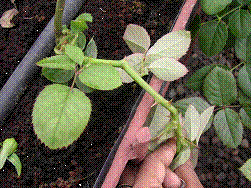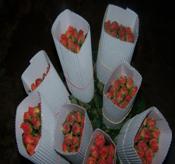
|
|||||||||||||||||||||||
Horticulture :: Flower Crops :: Cut rose |
|||||||||||||||||||||||
Varieties
Soil and climate Propagation and planting Planting of Rose
Support of the plants Disbudding |
|||||||||||||||||||||||
|
|
Bending |
|
Defoliation
The removal of leaves is known as defoliation. It is done mainly to induce certain plant species to flower or to reduce transpiration loss during periods of stress. Defoliation may be done by removal of leaves manually or by withholding water. The shoots are defoliated after pruning.
Manuring
At three months interval, apply FYM at 10 kg and 8:8:16 g NPK/plant after each pruning. For cv. Happiness NPK may be applied @ 75:150:50 g/plant/year.
Harvest
Harvesting is done with sharp secateure at the tight bud stage when the colour is fully developed and the petals have not yet started unfolding. There should be 1-2 mature leaves (those with five leaflets) left on the plant after the flower has been cut. The reason for leaving these matures leaves is to encourage production of new strong shoots. Harvesting is done preferably during early morning hours.
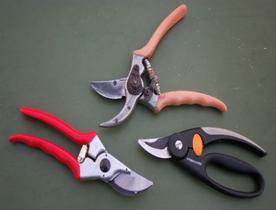

Secateur for harvest Harvesting technique
Postharvest handling
Roses must be placed in a bucket of water inside the polyhouse immediately after harvesting and transported to cold storage (2-4°C). The length of time depends upon the variety and quality of the roses.The flowers are graded according to the length. It varies from 40-70 cm depending on the variety and packed in 10/12 per bunch.
 |
|
|
Pre cooling |
Grading |
Packing |
Physiological disorders
Blind wood
The normal flowering shoot on a greenhouse rose possesses fully expanded sepals, petals, and reproductive parts. The failure to develop a flower on the apical end of the stem is a common occurrence. Such shoots are termed as blind wood. The sepals and petals are present, but the reproductive parts are absent or aborted. Blind wood is generally short and thin, but it may attain considerable length and thickness when it develops at the top of the plant. This may be caused by low temperature, insufficient light, chemical residues, insect, pests, fungal diseases and other factors.
Bull heads or malformed flowers
The center petals of the bud remain only partly developed and the bud appears flat. They are common on very vigorous shoots, particularly bottom breaks, and it is possible that there is a lack of carbohydrates to develop the petals. The cause of bull heading is yet unknown, however, thrips infestation will also cause malformed flowers. Also at low temperature, some varieties will form bull heads.
Colour fading
The off- coloured flowers are seem to be a problem with some yellow varieties. In these varieties the petals may be green or a dirty white instead of a clear yellow. Raising the night temperature several degrees will reduce the number of off-coloured flowers. Occasionally the pink or red varieties develop bluish-coloured flowers. This is very often associated with use of organic phosphate and various other kinds of insecticides.
Limp necks
The area of the stem just below the flower “wilts” and will not support the head. This may be due to insufficient water absorption; cutting off the lower 1 to 2 inches of stem and placing the cut stem in water at 37°C will revive the flower.
Blackening of rose petals
This is caused by low temperature and high anthocyanin content. GA3 treatment causes accumulation of anthocyanin in petals of Baccara roses. This effect was more pronounced at low temperature (20°C at day and 4°C at night) than in higher temperature (30°C at day and 20°C at night).
Nutritional disorders
Iron deficiencies can cause pale foliage. Adjusting the pH of the soil may solve this problem.
Yield
The Hybrid Teas roses can yield about 70 – 80 stems/plant/year, while the Floribundas yield yields 80 -90 stems/plant/year.
Source
1. http://www.rose-bushes.com/images/pruning-roses.jpg
2. http://www.ausgarden.com.au/files/13/Secx3.jpg
3. http://i.ehow.com/images/GlobalPhoto/Articles/2177387/pruneroses-main_Full.jpg
© All Rights Reserved. TNAU-2015.


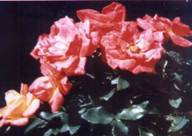
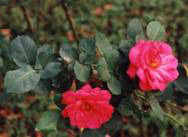
![pruning-roses[1]](horti_flower crops_cut rose_clip_image008_0002.jpg)

